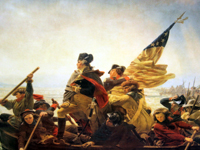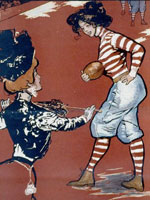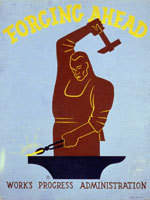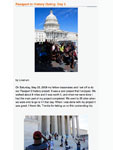Oregon: 6th-Grade Standards
(Note: By the completion of eighth grade, Oregon students are expected to master the following standards.)
Benchmark 3 students expand their study to U.S. and World History, including early world civilizations and the development of nations and the United States post-Revolution to approximately 1900. Students increase their understanding of the U.S. Constitution, rule of law, and the powers and limitations of government. They apply their geography skills to identify physical features, population distribution, and to make predictions. Students also examine markets and types of economies, with emphasis on the U.S. economy. They also study basic investment and savings concepts and practices. Students continue to use Social Science Analysis skills, examining evidence more completely, viewing issues from more than one perspective, and making judgments about alternative responses or solutions to problems.
Civics and Government
-
Understand the origins, purposes, and functions of U.S. government, including the structure and meaning of the U.S. Constitution.
-
SS.08.CG.01 Understand the purposes of government as stated in the Constitution and the specific provisions that limit the power of government in order to protect the rights of individuals.
- SS.08.CG.01.01 Distinguish the purposes of government as stated in the Preamble.
- SS.08.CG.01.02 Understand how the power of government is limited in the United States.
- SS.08.CG.01.03 Recognize the provisions of the Bill of Rights (Amendments 1-10) that protect individual rights.
-
SS.08.CG.01 Understand the purposes of government as stated in the Constitution and the specific provisions that limit the power of government in order to protect the rights of individuals.
-
Understand the organization, responsibilities, and interrelationships of local, state, and federal governments in the United States.
-
SS.08.CG.02 Identify and distinguish how powers and responsibilities are distributed and balanced among the federal, state, and local levels.
- SS.08.CG.02.01 Identify the power or responsibility of each level of government.
- SS.08.CG.02.02 Understand how laws are made and enforced at the federal, state, and local levels.
-
SS.08.CG.02 Identify and distinguish how powers and responsibilities are distributed and balanced among the federal, state, and local levels.
-
Understand the roles of the three branches of government and explain how their powers are distributed and shared.
-
SS.08.CG.03 Understand the powers of each branch of government as stated in the Constitution.
- SS.08.CG.03.01 Understand the basic idea of checks and balances of each branch of the federal government.
- SS.08.CG.03.02 Identify the legislative, executive, and judicial institutions at each level of government.
- SS.08.CG.03.03 Understand the powers and responsibilities of the executive branch of government.
- SS.08.CG.03.04 Understand how courts are organized by level and jurisdiction, and that law is divided into Constitutional Law, criminal law, and civil law.
-
SS.08.CG.03 Understand the powers of each branch of government as stated in the Constitution.
-
Understand personal and political rights of citizens in the United States.
-
SS.08.CG.04 Understand citizens' rights and how the Constitution protects those rights.
- SS.08.CG.04.01 Identify and understand the rights of citizens guaranteed under the Bill of Rights.
-
SS.08.CG.04 Understand citizens' rights and how the Constitution protects those rights.
-
Understand participatory responsibilities of citizens in the community (voluntarism) and in the political process (becoming informed about public issues and candidates, joining political parties/interest groups/associations, communicating with public officials, voting, influencing lawmaking through such processes as petitions/initiatives).
-
SS.08.CG.05 Understand how citizens can make their voices heard in the political process.
- SS.08.CG.05.01 Identify and give examples of ways that citizens can let their opinions be known in the political process.
-
SS.08.CG.05 Understand how citizens can make their voices heard in the political process.
-
Understand how government is influenced and changed by support and dissent of individuals, groups, and international organizations.
-
SS.08.CG.06 Identify and give examples of how groups and organizations can influence the actions of government.
- SS.08.CG.06.01 Identify and give examples of how groups and organizations can influence government policy or decisions and describe how these actions can lead to such influence.
-
SS.08.CG.06 Identify and give examples of how groups and organizations can influence the actions of government.
-
Understand how nations interact with each other, how events and issues in other countries can affect citizens in the United States, and how actions and concepts of democracy and individual rights of the United States can affect other peoples and nations.
-
SS.08.CG.07 Understand how actions of the U.S. government affect citizens of both the United States and other countries.
- SS.08.CG.07.01 Know how the U.S. government affects citizens of other countries.
- SS.08.CG.07.02 Know how U.S. government actions with other nations affect citizens of the United States.
-
SS.08.CG.07 Understand how actions of the U.S. government affect citizens of both the United States and other countries.
-
Analyze major political systems of the world.
-
SS.08.CG.08 Understand various forms of government.
- SS.08.CG.08.01 Compare and contrast various forms of government to the United States' government.
-
SS.08.CG.08 Understand various forms of government.
Economics
-
Understand that resources are limited (e.g., scarcity).
-
SS.08.EC.01 Understand incentives in a market economy that influence individuals and businesses in allocating resources (time, money, labor, and natural resources).
- SS.08.EC.01.01 Know that people respond predictably to positive and negative incentives.
-
SS.08.EC.01 Understand incentives in a market economy that influence individuals and businesses in allocating resources (time, money, labor, and natural resources).
-
Understand economic trade-offs and how choices result in both costs and benefits to individuals and society.
-
SS.08.EC.02 Understand how trade-offs and opportunity costs can be identified and measured.
- SS.08.EC.02.01 Know and give examples of how changes in the economy impose costs on some and benefits on others because they arbitrarily redistribute purchasing power.
- SS.08.EC.02.02 Distinguish between "needs" and "wants" in the U.S. and other countries of the world, and the impact of the media.
-
SS.08.EC.02 Understand how trade-offs and opportunity costs can be identified and measured.
-
Understand how conditions in an economy influence and are influenced by the decisions of consumers, producers, economic institutions, and government.
-
SS.08.EC.03 Understand how price is an incentive for both buyers and producers/sellers in the marketplace.
- SS.08.EC.03.01 Understand how supply and demand respond predictably to changes in economic circumstances.
-
SS.08.EC.03 Understand how price is an incentive for both buyers and producers/sellers in the marketplace.
-
Understand economic concepts, principles, and factors affecting the allocation of available resources in an economy.
-
SS.08.EC.04 Understand how decisions regarding what to produce, how to produce, and for whom to produce are answered in various economic systems.
- SS.08.EC.04.01 Understand how decisions about production are made in traditional, capitalist, and command economies.
-
SS.08.EC.04 Understand how decisions regarding what to produce, how to produce, and for whom to produce are answered in various economic systems.
-
Understand the role of government and institutions (i.e., banks, labor unions) in various economic systems in an economy.
-
SS.08.EC.05 Understand how banks function within the economy.
- SS.08.EC.05.01 Identify and give examples of the services of a bank, and know the role of banks in the economy.
-
SS.08.EC.05 Understand how banks function within the economy.
- Understand the interdependence of the global economy and the role played by the United States.
-
SS.08.EC.06 Identify and give examples of how the United States economy affects citizens of both the United States and other countries.
- SS.08.EC.06.01 Give examples of how the United States economy affects citizens of the United States.
- SS.08.EC.06.02 Give examples of how the United States economy affects citizens of other countries.
-
Understand how money makes it easier to trade, borrow, save, invest, and compare the value of goods and services.
-
SS.08.EC.07 Understand the function of money.
- SS.08.EC.07.01 Understand how money functions as a means of exchange, a store of value, and a measure of value.
-
SS.08.EC.07 Understand the function of money.
-
Apply economic concepts and principles to issues of personal finance.
-
SS.08.EC.08 Understand factors that determine personal income and predict future earnings, based on plans for education and training.
- SS.08.EC.08.01 Understand how a wage or salary is the price of labor, and is usually determined by the supply and demand for labor.
- SS.08.EC.08.02 Understand that people's incomes, in part, reflect choices they have made about education, training, skill development, and careers.
- SS.08.EC.08.03 Understand how workers can increase their productivity by improving their skills or by using tools and machinery.
-
SS.08.EC.09 Understand different ways that people invest and save.
- SS.08.EC.09.01 Understand that banks and credit unions are institutions where people save money and earn interest, and where other people borrow money and pay interest.
- SS.08.EC.09.02 Understand that stocks, bonds, and other investments are ways people earn money.
-
SS.08.EC.08 Understand factors that determine personal income and predict future earnings, based on plans for education and training.
Geography
-
Understand the spatial concepts of location, distance, direction, scale, movement, and region.
-
SS.08.GE.01 Understand fundamental geography vocabulary such as concepts of distance, latitude, longitude, interdependence, accessibility, and connections.
- SS.08.GE.01.01 Use maps, charts, and graphs to understand patterns of movement over time and space.
-
SS.08.GE.01 Understand fundamental geography vocabulary such as concepts of distance, latitude, longitude, interdependence, accessibility, and connections.
-
Use maps and other geographic tools and technologies to acquire, process, and report information from a spatial perspective.
-
SS.08.GE.02 Read, interpret, and understand how to construct geographic representations to analyze information, understand spatial relationships, and compare places.
- SS.08.GE.02.01 Use maps, charts, graphs, and photographs to analyze spatial distributions and patterns.
-
SS.08.GE.02 Read, interpret, and understand how to construct geographic representations to analyze information, understand spatial relationships, and compare places.
-
Locate major physical and human (cultural) features of the Earth.
-
SS.08.GE.03 Locate and identify on maps and globes the regions of the world and their prominent physical features.
- SS.08.GE.03.01 Identify the location of major mountain ranges, deserts, rivers, cultural regions and countries in the world.
-
SS.08.GE.03 Locate and identify on maps and globes the regions of the world and their prominent physical features.
-
Compare and analyze physical (e.g., landforms, vegetation, wildlife, climate, and natural hazards) and human (e.g., population, land use, language, and religion) characteristics of places and regions.
-
SS.08.GE.04 Identify and compare physical and human characteristics of major regions and significant places in the world.
- SS.08.GE.04.01 Locate and identify population centers and geographic reasons for their locations.
- SS.08.GE.04.02 Identify, locate, and compare the cultural characteristics of places and regions.
- SS.08.GE.04.03 Recognize relationships between the physical and cultural characteristics of a place or region.
-
SS.08.GE.04 Identify and compare physical and human characteristics of major regions and significant places in the world.
-
Analyze the causes of human migration (e.g., density, food and water supply, transportation and communication systems) and it effects (e.g., impact on physical and human systems).
-
SS.08.GE.05 Identify and understand worldwide patterns of population distribution, migration, and cultural diffusion and interactions.
- SS.08.GE.05.01 Identify patterns of population distribution and infer causes.
- SS.08.GE.05.02 Recognize and identify patterns of migration streams in U.S. history.
- SS.08.GE.05.03 Understand how migration streams affect the spread of cultural traits.
-
SS.08.GE.05 Identify and understand worldwide patterns of population distribution, migration, and cultural diffusion and interactions.
-
Understand economic, cultural, and environmental factors that influence changes in population, and evaluate the consequences of the resulting increases or decreases in population.
-
SS.08.GE.06 Identify economic, cultural, and environmental factors that affect population, and predict how the population would change as a result.
- SS.08.GE.06.01 Identify and give examples of economic, cultural, and environmental factors that influence population.
- SS.08.GE.06.02 Predict the effect of a given economic, cultural, or environmental change on a population.
-
SS.08.GE.06 Identify economic, cultural, and environmental factors that affect population, and predict how the population would change as a result.
-
Understand how people and the environment are interrelated.
-
SS.08.GE.07 Understand how human modification of the physical environment in a place affects both that place and other places.
- SS.08.GE.07.01 Understand how the process of urbanization affects the physical environment of a place, the cultural characteristics of a place, and the physical and human characteristics of the surrounding region.
- SS.08.GE.07.02 Understand how clearing vegetation affects the physical environment of a place and other places.
-
SS.08.GE.08 Understand how changes in a physical environment affect human activity.
- SS.08.GE.08.01 Understand how changes in the physical environment can increase or diminish capacity to support human activity.
- SS.08.GE.08.02 Understand how climatic events or climate change affect human activity.
- SS.08.GE.08.03 Predict how changes in an ecosystem (not caused by human activity) might influence human activity.
-
SS.08.GE.07 Understand how human modification of the physical environment in a place affects both that place and other places.
History
-
Historical Skills: Interpret and reconstruct chronological relationships.
-
SS.08.HS.01 Represent and interpret data and chronological relationships from history, using timelines and narratives.
- SS.08.HS.01.01 Identify and create chronologies of events.
- SS.08.HS.01.02 Compare and contrast historical interpretations.
-
SS.08.HS.01 Represent and interpret data and chronological relationships from history, using timelines and narratives.
-
Historical Skills: Analyze cause and effect relationships, including multiple causalities.
- SS.08.HS.02 Distinguish between cause and effect relationships and events that happen or occur concurrently or sequentially.
-
Historical Skills: Understand, recognize, and interpret change and continuity over time.
- SS.08.HS.03 Identify and give examples of chronological patterns and recognize them in related events over time.
-
Historical Skills: Identify and analyze diverse perspectives on and historical interpretation of historical issues and events.
- SS.08.HS.04 Evaluate data within the context in which it was created, testing its reliability, credibility, and bias.
-
World History: Understand and interpret events, issues, and developments within and across eras of world history.
-
SS.08.HS.05 Understand the political, economic, and cultural impact, and lasting influence of early civilizations on world development.
- SS.08.HS.05.01 Understand the major characteristics and historical influence of the early civilizations of Mesopotamia, Indus River Valley, Egypt, the Americas, Greece.
- SS.08.HS.05.02 Identify and give examples of the political, economic, and social characteristics of the Roman Republic and Empire, and how they are reflected in the law, government, economy and society of the United States.
- SS.08.HS.05.03 Understand the importance of the rise of Islam and its interaction with Europe.
- SS.08.HS.05.04 Understand the development of the empires and kingdoms of sub-Saharan Africa, Imperial China, and feudal Japan.
- SS.08.HS.05.05 Understand the major developments and societal impact of feudalism, the church, and the rise of cities in the European Middle Ages.
- SS.08.HS.05.06 Understand the characteristics and impact of Renaissance thinking, art, and learning.
-
SS.08.HS.05 Understand the political, economic, and cultural impact, and lasting influence of early civilizations on world development.
-
U.S. History: Understand and interpret events, issues, and developments within and across eras of U.S. history.
-
SS.08.HS.06 Understand how individuals, issues, and events changed or significantly influenced the course of U.S. history post-American Revolution through 1900.
- SS.08.HS.06.01 Identify and understand the issues and events that were addressed at the Constitutional Convention.
- SS.08.HS.06.02 Trace the route and understand the significance of the Lewis and Clark Expedition.
- SS.08.HS.06.03 Understand the effects of 19th century westward migration, the idea of Manifest Destiny, European immigration, and rural to urban migration on indigenous populations and newcomers in the United States.
- SS.08.HS.06.04 Understand the effects of Jacksonian Democracy on political practices.
- SS.08.HS.06.05 Recognize and understand conditions of the African slave trade and experiences of enslaved African-Americans and "free Blacks" in the United States.
- SS.08.HS.06.06 Understand how the abolitionists advocated for the end of slavery and the impact of their activities.
- SS.08.HS.06.07 Understand how African-Americans dealt with the conditions of their enslavement and used religion and family to create a viable culture to cope with the effects of slavery.
- SS.08.HS.06.08 Identify and understand the events that led to the Civil War.
- SS.08.HS.06.09 Understand the political, economic, and social causes, course, and impact of the Civil War.
- SS.08.HS.06.10 Understand how Reconstruction affected the country.
- SS.08.HS.06.11 Identify and understand constitutional changes that resulted from the Civil War and Reconstruction.
- SS.08.HS.06.12 Understand the effects of Indian Wars and the opening of the West on Native American tribes.
- SS.08.HS.06.13 Understand the effects of the Irish potato famine in the mid-1800s on the U.S. society.
- SS.08.HS.06.14 Understand the motivations for territorial expansion to the Pacific Ocean/Hawaii ("Manifest Destiny").
- SS.08.HS.06.15 Understand the effect of territorial expansion on other nations and their people.
-
SS.08.HS.06 Understand how individuals, issues, and events changed or significantly influenced the course of U.S. history post-American Revolution through 1900.
-
State & Local History: Understand and interpret the history of the state of Oregon.
-
SS.08.HS.07 Understand how various groups of people were affected by events and developments in Oregon state history.
- SS.08.HS.07.01 Identify and understand significant events, developments, groups, and people in the history of Oregon from post-American Revolution until 1900.
- SS.08.HS.07.02 Understand the interactions and contributions of the various people and cultures that have lived in or migrated to the area that is now Oregon from post-American Revolution until 1900.
-
SS.08.HS.07 Understand how various groups of people were affected by events and developments in Oregon state history.
-
State & Local History: Understand and interpret events, issues, and developments in the history of one’s family, local community, and culture.
- SS.08.HS.08 Understand the lasting influence of events and developments in local history.
Social Science Analysis
-
Define and clarify an issue so that its dimensions are well understood.
- SS.08.SA.01 Clarify key aspects of an event, issue, or problem through inquiry and research.
-
Acquire and organize materials from primary and secondary sources.
- SS.08.SA.02 Gather, interpret, use, and document information from multiple sources, distinguishing facts from opinions and recognizing points of view.
-
Explain various perspectives on an event or issue and the reasoning behind them.
- SS.08.SA.03 Examine a controversial event, issue, or problem from more than one perspective.
-
Identify and analyze an issue.
- SS.08.SA.04 Examine the various characteristics, causes, and effects of an event, issue, or problem.
-
Select a course of action to resolve an issue.
- SS.08.SA.05 Consider two or more outcomes, responses, or solutions; identify their strengths and weaknesses; then conclude and justify which is the best.






 That same year, an after-school group that is co-sponsored by myself and a friend from the National Park Service took a cross-country trip for Lincoln’s Bicentennial. I created another blog for the students to document their adventures and for friends and family back home to be able to find us. What was nice was that because I had been working with the blog in history class, my students were aware of how a blog works and were familiar with how to write for it and their audience. Each student was required to write three times for the blog during the course of our week-long adventure. Each night after our full day they would write on either paper or share the two laptops we brought for blogging. Before going to bed each night I would upload any remaining blog entries. The system proved effective for sharing our adventures and for students documenting their days. The site has also become a great way for Jen Epstein, my National Park Service co-organizer, to share what she is doing in schools for outreach. View it here:
That same year, an after-school group that is co-sponsored by myself and a friend from the National Park Service took a cross-country trip for Lincoln’s Bicentennial. I created another blog for the students to document their adventures and for friends and family back home to be able to find us. What was nice was that because I had been working with the blog in history class, my students were aware of how a blog works and were familiar with how to write for it and their audience. Each student was required to write three times for the blog during the course of our week-long adventure. Each night after our full day they would write on either paper or share the two laptops we brought for blogging. Before going to bed each night I would upload any remaining blog entries. The system proved effective for sharing our adventures and for students documenting their days. The site has also become a great way for Jen Epstein, my National Park Service co-organizer, to share what she is doing in schools for outreach. View it here: